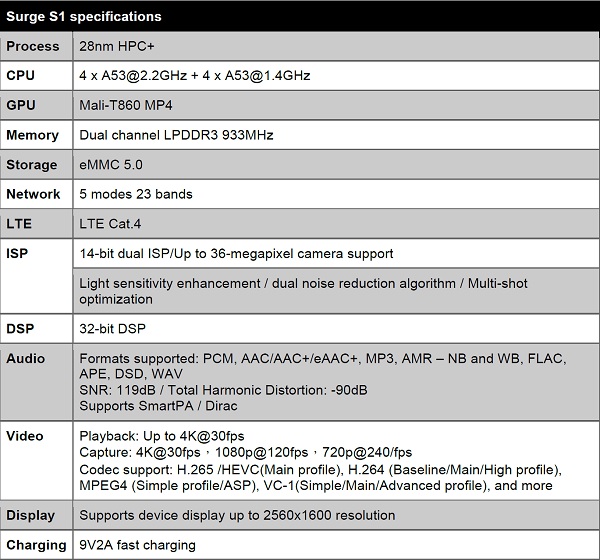Xiaomi becomes the 4th smartphone manufacturer in the world to make in-house chipset on their smartphones. And the Xiaomi Mi 5C will be the first to use the Surge S1 chipset. With so many smartphone competitors in China, it is refreshing to see Xiaomi breaking the norm. With Surge S1, the power management and performance of the chip are tuned perfectly to suit Xiaomi smartphones.

Press Release
Xiaomi announces its own chipset “Surge S1”
Company’s first SoC designed and developed in-house will power the new Mi 5c smartphone
BEIJING, 28 February 2016 — Xiaomi today announced Surge S1, the company’s first in-house chipset, marking a major milestone in the development of the seven year-old consumer technology company. With the launch of Surge S1, Xiaomi becomes only the fourth smartphone manufacturer in the world to create a chipset that has been designed and developed inhouse. Alongside Surge S1, the company announced its newest smartphone Mi 5C, which is powered by the Surge S1 chipset.
Lei Jun, CEO and co-founder of Xiaomi, said: “The ability to create its own chipsets is the pinnacle achievement for any smartphone company. For Xiaomi, the move is an essential next step in our development. In order to deliver on our promise to make innovation available to everyone, we need to master the core technologies of our industry and tightly integrate the development of our hardware with our software, helping us to make even better smartphones that will consistently surprise the industry and delight consumers.”
In creating a 10-year roadmap for Xiaomi’s development in 2014, Lei Jun quickly realized that for the company to achieve its long-term objectives, it would have to combine the development of hardware and software technologies, especially at the chipset level. Pinecone, a fully-owned subsidiary of Xiaomi, was set up to start research and development into designing and developing a chipset. Within 28 months, Xiaomi has today announced its very own chipset Surge S1.
The pursuit of technological innovation lies at the core of Xiaomi. To date, it has applied for over 16,000 patents, among which it has been granted 3612, including 1767 international patents.
As Xiaomi’s first in-house chipset, Surge S1 uses a high-performance octa-core ARM Cortex-A53 processor with a big.LITTLE design, incorporating four 2.2GHz cores and four 1.4Ghz cores, achieving a balance between performance and power efficiency. In the Geekbench benchmark, Surge S1 outperformed other chipsets in its range such as Snapdragon 625. With an integrated Mali T-860 MP4 GPU, superb graphics performance in gaming and 4K video is made possible while using up to 40 percent less power than the last-generation Mali GPU. Equipped with a 32-bit DSP supporting VoLTE and 16kHz sampling, Surge S1 works wonders with sound, resulting in high-quality voice calls even in noisy environments.
Surge S1 also comes with an in-house image signal processor (ISP) developed by Xiaomi. The 14-bit dual ISP features increased light sensitivity by up to 150 percent and a dual noise reduction algorithm that reduces noise and preserves detail, resulting in incredible images even in challenging lighting situations.
Mi 5c: Xiaomi’s first smartphone powered by Surge S1
Alongside Surge S1, Xiaomi also launched Mi 5c, the very first smartphone to showcase the advantages of Surge S1, all in a beautiful metal body with a 5.15-inch display. Measuring a svelte 7.09mm thick, Mi 5c is amazingly light at just 135g.
The use of 16 LEDs for the display backlight gives the screen on Mi 5c an incredibly crisp 550-nit maximum brightness. The Surge S1 chipset is able to intelligently adjust the Mi 5c screen between 2048 brightness levels to match ambient light levels, allowing for smooth transitions between light and dark surroundings that maximize eye comfort whether walking into a building, riding on a train, or simply turning out the light at night.
In addition, the Mi 5c screen has a 1500:1 contrast ratio for darker blacks and brighter whites, as well as a 94.4% NTSC colour gamut, which delivers incredibly sharp images and remarkably lifelike colours. Mi 5c also offers a Reading mode to make long reading sessions more comfortable.
Mi 5c comes with a 1.25μm ultra light-sensitive 12-megapixel camera with six-element lens. The 14-bit dual ISP on Surge S1 is used on Mi 5c for great photo-taking capabilities, delivering features such as light sensitivity enhancement and a dual noise reduction algorithm. Compared to traditional HDR, Mi 5c also supports dynamic real-time adjustment and pixel-level screen adjustment for better-looking images.
Mi 5c will be available in China starting March 3 at RMB 1499 through Mi.com, Suning’s online site, and Tmall, as well as all Mi Home stores and Suning offline stores.

About Xiaomi
Xiaomi was founded in 2010 by serial entrepreneur Lei Jun based on the vision “innovation for everyone”. We believe that high-quality products built with cutting-edge technology should be made accessible to everyone. We create remarkable hardware, software, and Internet services for and with the help of our Mi fans. We incorporate their feedback into our product range, which currently includes Mi and Redmi smartphones, Mi TVs and set-top boxes, Mi routers, and Mi Ecosystem products including smart home products, wearables and other accessories. With more than 70 million handsets sold in 2015, Xiaomi is expanding its footprint across the world to become a global brand.
